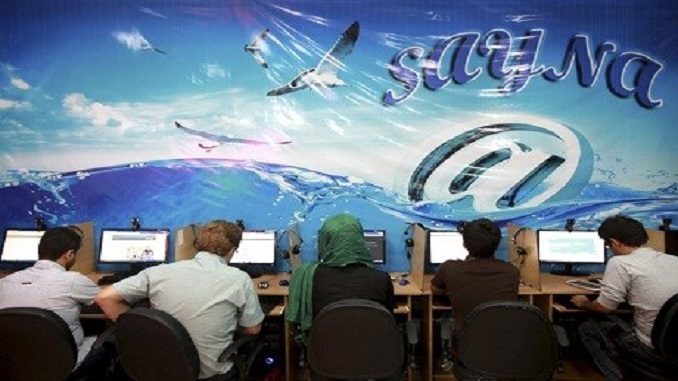
Three senior clerics affiliated with Ali Khamenei, Iran regime’s Supreme Leader, Ahmad Jannati, Sadegh Larijani and Ahmad Khatami, emphasized that the recent unrest and uprising in Iran was directly related to cyberspace, Track Persia reports.
Jannati announced that recently Khamenei had a meeting with “cyberspace experts” and “they are supposed to make a move.” Ahmad Khatami said that “if this space is released, it will be problematic again.” On Thursday, January 25, Sadegh Amoli Larijani, the head of the regime’s judiciary, at a gathering of heads of judiciary and prosecutors, emphasized the sensitivity of cyberspace, saying:
“Cyberspace in our country, as it is managed today, is 100% against the national security. …Enemies can acquire various information from within our country, and through access to the audience’s tastes, while spreading a variety of rumours, act against the system (regime) and security of the country. We never want to close the cyberspace, but we say we have to create our own safe path for our citizens to have a choice. This problem must be resolved as soon as possible, and beside it, all security devices are required to deal with the local branches that cooperate with the enemies and foreigners in the cyberspace.”
Jannati, the head of the regime’s Assembly of Experts announced that “the leader (Khamenei) had a meeting with a number of cyberspace specialists for a few hours on Tuesday (January 23) and had serious talks about this issue and they are supposed to make a move. But it’s important to know what to do and who should do it.”
“We must dismiss the people who are incapacitated and hire the mighty ones. So there should be changes in this organization,” he added.
Jannati explicitly said “cyberspace is a blow to our life” and added: “If they controlled the cyberspace earlier, they could prevent it from going so fast… and we wouldn’t have so many problems. I have said that we cannot totally block the cyberspace but we can slow it down.” Ahmad Khatami, spokesman for the regime’s Board of the Assembly of Experts, told reporters that members of the Assembly of Experts have warned about the recent disturbances (uprising) in Iran. He then added:
“We must be careful that form such cases (unrest) do not form again. All the attendees at the meeting (of the Assembly of Experts’ Commissions) were worried about cyberspace and explicitly said that the administrators of the recent turmoil (unrests) were cyberspace seditionists. If this space is released, it will be problematic again,” Ahmad Khatami said adding, “Officials should be careful about this.”
Following the widespread protests in Iran, the Iranian regime authorities referred to Telegraph and Instagram as a threat to the regime’s national security because of the protesters using these social networks.
As the protests spread all over Iran, these networks were filtered by the regime, but after a while, the regime was forced under pressures to remove filtering of these two networks. The U.S. government also announced new sanctions targeting some individuals and entities of the Iranian regime, including the regime’s Supreme Council of Cyberspace, the Revolutionary Guards Cyber-Defense Center, and several other entities, due to their role in limiting the access of Iranian users to the Internet and the international media.
According to the state-run Mehr news agency on Friday, quoting the National Cyberspace Research Institute, during the period from January 14 to 22, more than 10,000 Persian channels were created in the Telegram. Based on these statistics, the number of channels created in the telegram has increased from 743,000 channels in late December to 754,000 channels in January. According to the report, 264 thousand and 347 channels are updated daily.
As Iran approaches the 40th anniversary of the revolution that brought its cleric-led rule to power, how it handles the power of cyberspace will be crucial to its future, determining whether it moves to greater openness or seals itself off from the world.
“The Islamic Republic is not black and white. It shows a myriad of contradictions and its Internet policy … is one of the great examples of those contradictions,” said Sanam Vakil, an associate fellow at Chatham House who studies Iran. “The government has taken the Internet and effectively used it for its own purposes and also has realized the dangers of it as well.”
Since the 1979 Islamic Revolution, how information spreads across mass media has been tightly controlled.
All television and radio broadcasts within Iran are from state-run stations. Satellite dishes remain ostensibly illegal, though they are plentiful, drawing occasional attacks from bat-wielding government enforcers. Journalists face restrictions in what they can cover and where they can travel across a country of 80 million people that’s nearly two-and-a-half times the size of Texas.
The Internet helped collapse that distance. During Iran’s 2009 protests surrounding the disputed re-election of hard-line President Mahmoud Ahmadinejad, still nascent social media spread word of the events among Iranians and brought videos of the shooting death of 26-year-old Neda Agha Soltan to the world.
